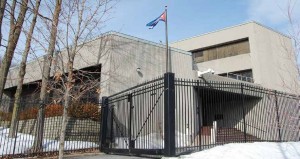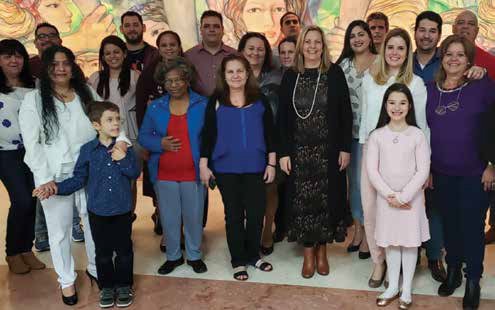Sandra Koch
Mammoth dark grey concrete blocks and foreboding secured metal fencing – not exactly the mental images conjured up when one thinks of Cuba. For the many Canadians who frequent this Caribbean island, Cuba is instead a destination noted for aquamarine beaches, historical Latin architecture and brightly painted retro cars.
Indeed, the warmth of the Cuban people and their vibrant culture seem to stand in stark contrast to the austere architecture of the concrete block building at 388 Main Street which houses the Cuban Embassy.

The concrete block architectural style of the Cuban Embassy, known as “Brutalism”, gives the building a fortress-like appearance that sharply contrasts with the warmth of the staffers who live and work inside. Photo by John Dance
Investigating the history of the Embassy sheds light on this seeming contradiction. Canada and Cuba’s trade goes back to the 18th century, in Atlantic Canada, where cod and potatoes were traded for sugar and rum. Diplomatic relations were formally established and have been uninterrupted since 1945.
But during the 1960s and 70s, there had been several bombings and threats to Cuban embassies in Ottawa, Montreal and around the world by anti-Castro groups based in the United States.
The Ottawa Embassy’s location was moved several times – originally located on Island Park Drive, it was moved to its current location at Main Street and Riverdale Avenue on land purchased in 1974.
Love it or hate it architecture
Cuban architect Sonia Dominguez designed this classic “brutalist” Embassy building, which was completed in 1976. Brutalism is a modernist architectural movement from the mid-20th century characterized by simple block-like structures with raw building materials, oftentimes concrete. Brutalism was often associated with European socialist ideology from the 1960s to the 1980s. Numerous examples of Brutalist architecture can be found around the world, including in Ottawa, where much of the city’s urban development occurred during the 1960s and 1970s. In addition to the Cuban Embassy, two other very prominent examples are the National Arts Centre and the Ottawa Central Library.
There are few who pass the Cuban Embassy without an opinion on the architecture. The popular style at the time of construction, coupled with the need for high-security standards, explains the fortress-like design of the Embassy as it stands today – it is definitely a “love it or hate it” architectural style.
Walk inside, however, and one is transported back to the 1970s. With the original mid-century design in immaculate condition, there is an emphasis on light and the use of natural materials.
A breathtaking wall-size mural highlights the main reception room, and guests are immediately awestruck by the beauty of this piece of artwork. In 1976, Cuban artist, Servando Cabrera Moreno was brought to the Embassy to paint “Asi amanece en Cuba” (“That’s how the sun rises in Cuba”), an illuminating depiction of everyday life in rural Cuba.
Architecture and design aside, the Embassy is a workplace for about 15 Cuban nationals, several of whom reside within the building in a private area separated from the working Embassy, with its offices and reception areas.
Cuban families embraced winter
One of the Embassy staffers, Areadna Quintana Castaneda, Third Secretary and Press-Culture Attaché explained to The Mainstreeter that there are three families from the Embassy residing nearby in Old Ottawa East. According to Castaneda, the families enjoy the community and their children attend schools in the area, have embraced winter and love playing in the snow and skating on the canal.

Areadna Quintana Castaneda, Third Secretary and Press-Culture Attaché at the Cuban Embassy resides in Sandy Hill and has felt accepted and welcomed in Canada since arriving almost two years ago. Photo Supplied
Castaneda is here with her husband, David Aldama Pando, also a Third secretary within the Embassy. They arrived almost two years ago and reside in Sandy Hill. The couple also enjoys the winter season and has taken up the challenge of learning to skate but find it “very difficult!”
The Embassy in Ottawa is one of the biggest of about 120 Cuban Embassies around the world and boasts many amenities that make it a very desirable destination for Cuban diplomats. The respectful and collaborative relationship between Canada and Cuba also contributes to the desirability of working here, according to Castaneda, who says the staff “feel accepted and welcome in Canada.”
The Cuban ambassador to Canada, Josefina Vidal Ferreiro and her husband, Minister Counsellor Jose Anselmo Lopez Perera were posted to Ottawa in March 2017. Prior to her arrival in Canada, Ambassador Ferreiro was the Director General, U.S. Division of the Ministry of Foreign Affairs in Cuba. In that role, she was a prominent negotiator and facilitator in restoring diplomatic relations between Cuba and the United States during the Obama government.
Despite its foreboding appearance, the Cuban Embassy is open for business each weekday morning and everyone is welcome. The Ottawa staff fulfills commercial and economic roles and provides full consular services to the public. Some tourist information is available, but the Tourism Boards are in the Cuban Consulates in Montreal and Toronto.
The Embassy enthusiastically celebrates Cuban holidays and culture throughout the year, engaging the Ottawa community at its many events. For example, they contribute a Cuban film each year to the popular Latin American Film Festival. Staff also arranged for the Cuban National Baseball team to visit in 2019 to play in the CANAM League and hosted a party for the Cuban and Ottawa teams to round out the series.
The highlight event of the year is the National Day of Cuba, which falls officially on January 1st, but is celebrated at the Ottawa Embassy at the end of the month. According to Castaneda, it is a lively, cultural celebration attended by politicians, diplomats, commercial and trade partners and community members.

Staff of the Cuban Embassy assemble in front of the wall-size mural depicting everyday life in Cuba that dominates the main reception area of the building which was completed in 1976. Photo Supplied
This year’s National Day event included a special celebration of the 75th Anniversary of the establishment of diplomatic relations between Canada and Cuba. An Embassy press release notes that Cuba has “great pride and appreciation in the relationship between our countries as diplomatic and commercial ties have grown stronger, but most importantly, the friendship between both peoples has been nurtured and strengthened.” With over a million Canadians visiting Cuba annually for the last nine years, and many Cubans choosing to make Canada their home, this relationship is bound to flourish.
While the political controversy surrounding Cuban politics cannot be overlooked, nonetheless, our neighbours at the Embassy on Main Street exemplify the warmth and hospitality of the Cuban people and their desire to share their vibrant culture with our community.






